Guide to Cable Tray Types: Finding the Right Fit
Last Updated: 11.7.2024
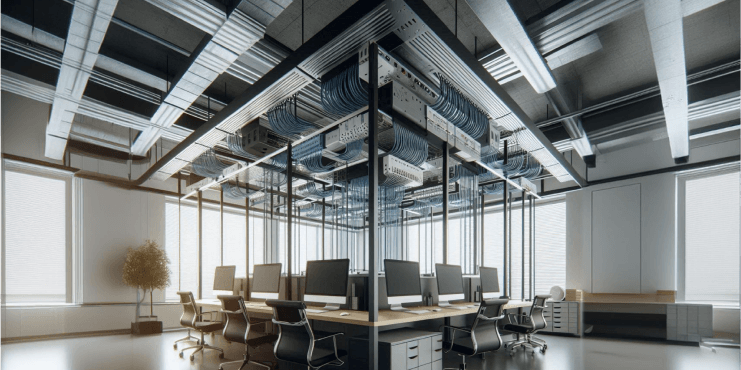
In the world of electrical and communication installations, cable trays play a pivotal role. They provide a structured pathway for cables and wires, ensuring protection, organization, and easy maintenance. With various types of cable trays available, each designed to meet specific needs, it's essential to understand their unique features, benefits, and applications. This guide explores the different types of cable trays, helping you make an informed decision for your next project.
1. Ladder Cable Trays
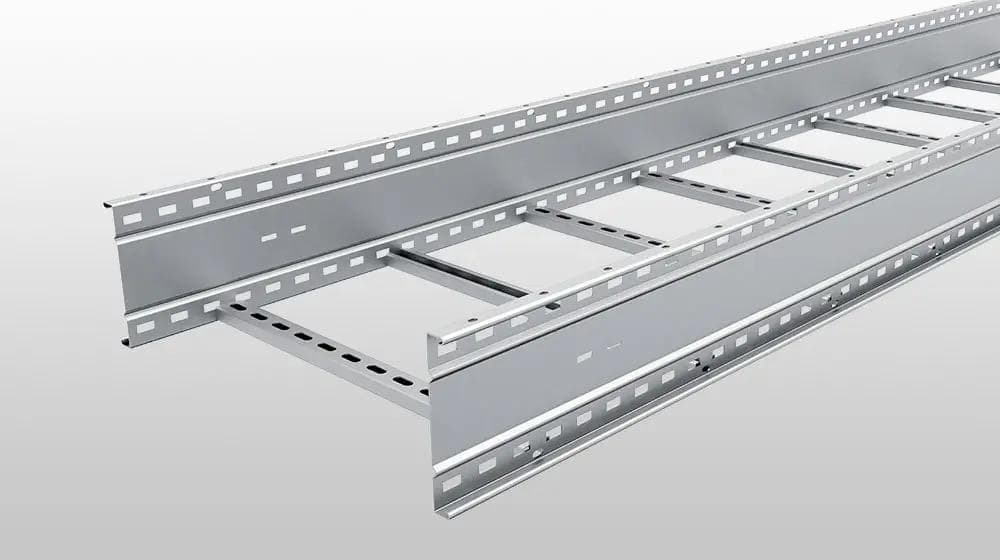
Ladder cable trays are among the most widely used types in industrial and commercial settings. They consist of two parallel side rails connected by rungs, creating a ladder-like structure. This design is particularly effective in supporting large volumes of cables.
Benefits
- Superior Ventilation: The open design allows for excellent airflow, which helps in dissipating heat generated by the cables, maintaining their efficiency and lifespan.
- Ease of Installation: Cables can be laid in and secured easily, simplifying the installation process and reducing labor costs.
- Accessibility: The open structure facilitates easy inspection and maintenance of the cables, ensuring quick identification and resolution of issues.
Applications
Ladder cable trays are ideal for environments where heat dissipation is critical, such as in industrial plants, power stations, and large commercial buildings. They are also suitable for installations with a high density of cables, where managing cable heat and maintaining easy access are priorities.
Size And Dimension
- Width: 6 inches to 36 inches (150mm to 900mm)
- Depth: 3 inches to 6 inches (75mm to 150mm)
- Length: 10 feet to 24 feet (3 meters to 7.5 meters)
- Rung Spacing: 9 inches to 12 inches (225mm to 300mm)
2. Perforated Cable Trays
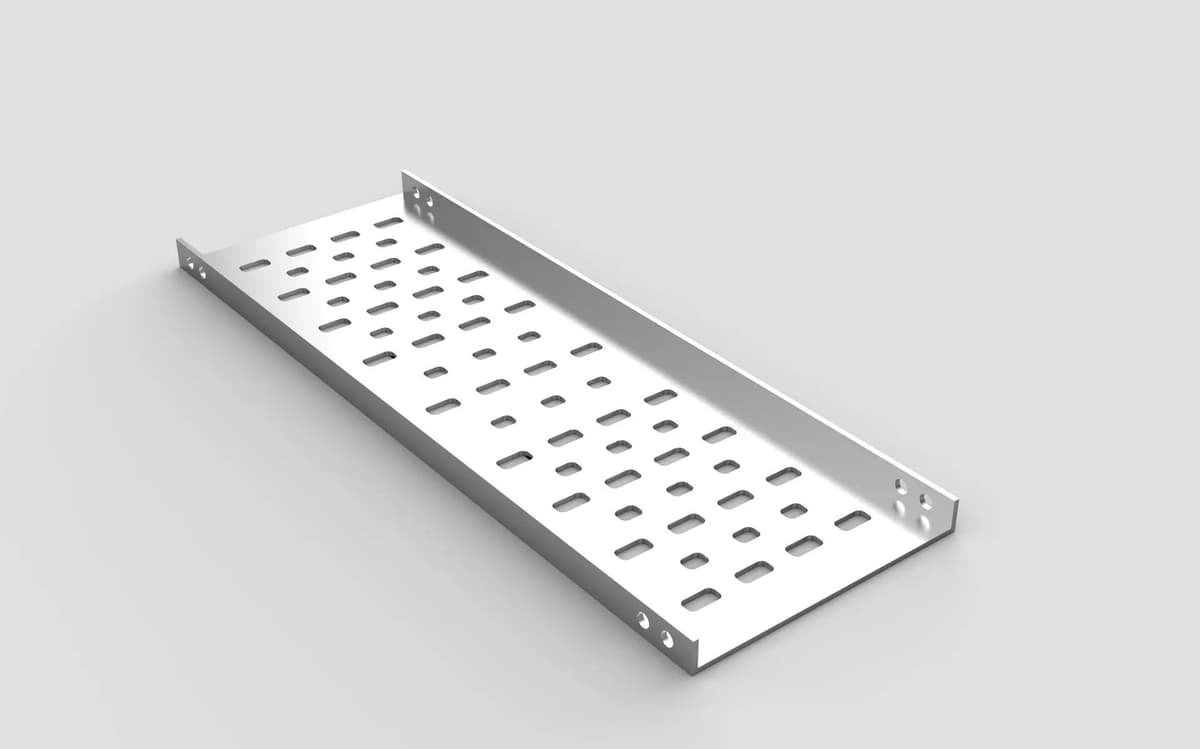
Perforated cable trays, also known as ventilated cable trays, feature a series of holes or slots punched into their bottom and sidewalls. These perforations provide moderate ventilation while maintaining a solid structure that offers better protection than ladder trays.
Benefits
- Moderate Ventilation: The perforations allow for airflow, helping to reduce heat buildup without compromising on structural integrity.
- Enhanced Protection: The partially enclosed design offers better protection against dust, debris, and mechanical damage compared to ladder trays.
- Versatility: Suitable for a wide range of cable types and sizes, making them a versatile option for various installations.
Applications
Perforated cable trays are commonly used in environments where both ventilation and protection are needed, such as in control rooms, data centers, and manufacturing facilities. They are also suitable for installations where moderate heat dissipation and cable protection are required.
Size and Dimension
-Width: 4 inches to 36 inches (100mm to 900mm)
- Depth: 1 inch to 6 inches (25mm to 150mm)
- Length: 8 feet to 12 feet (2.4 meters to 3.6 meters)
- Perforation Size: Varies, typically around 0.25 inches to 1 inch (6mm to 25mm)
3. Solid Bottom Cable Trays
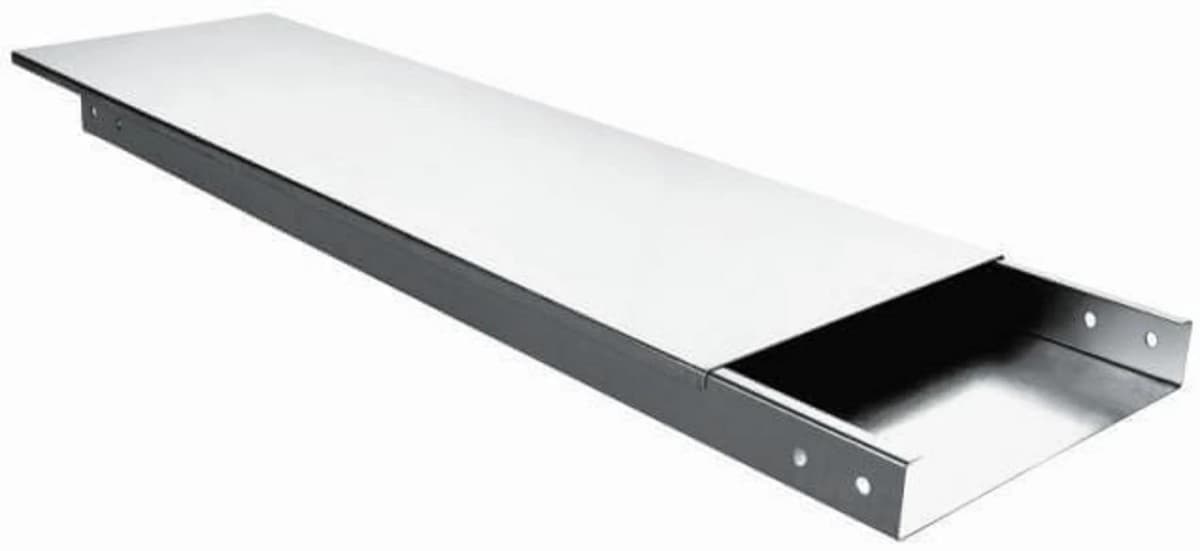
Solid bottom cable trays feature a completely solid bottom with no perforations. This design provides maximum protection for the cables, shielding them from environmental factors and physical damage.
Benefits
- Maximum Protection: The solid structure offers superior protection against dust, dirt, and other contaminants, making it ideal for sensitive cable installations.
- Optimal Support: Provides excellent support for delicate cables that may be prone to damage, ensuring their longevity and performance.
- Clean Aesthetics: The solid design can create a cleaner appearance, especially in visible installations, enhancing the overall look of the space
Applications
Solid bottom cable trays are perfect for environments where cable protection is paramount, such as in cleanrooms, laboratories, and other controlled environments. They are also suitable for installations with sensitive or high-voltage cables that require extra protection.
Size and Dimension
- Width: 4 inches to 36 inches (100mm to 900mm)
- Depth: 1 inch to 6 inches (25mm to 150mm)
- Length: 8 feet to 12 feet (2.4 meters to 3.6 meters)
4. Wire Mesh Cable Trays
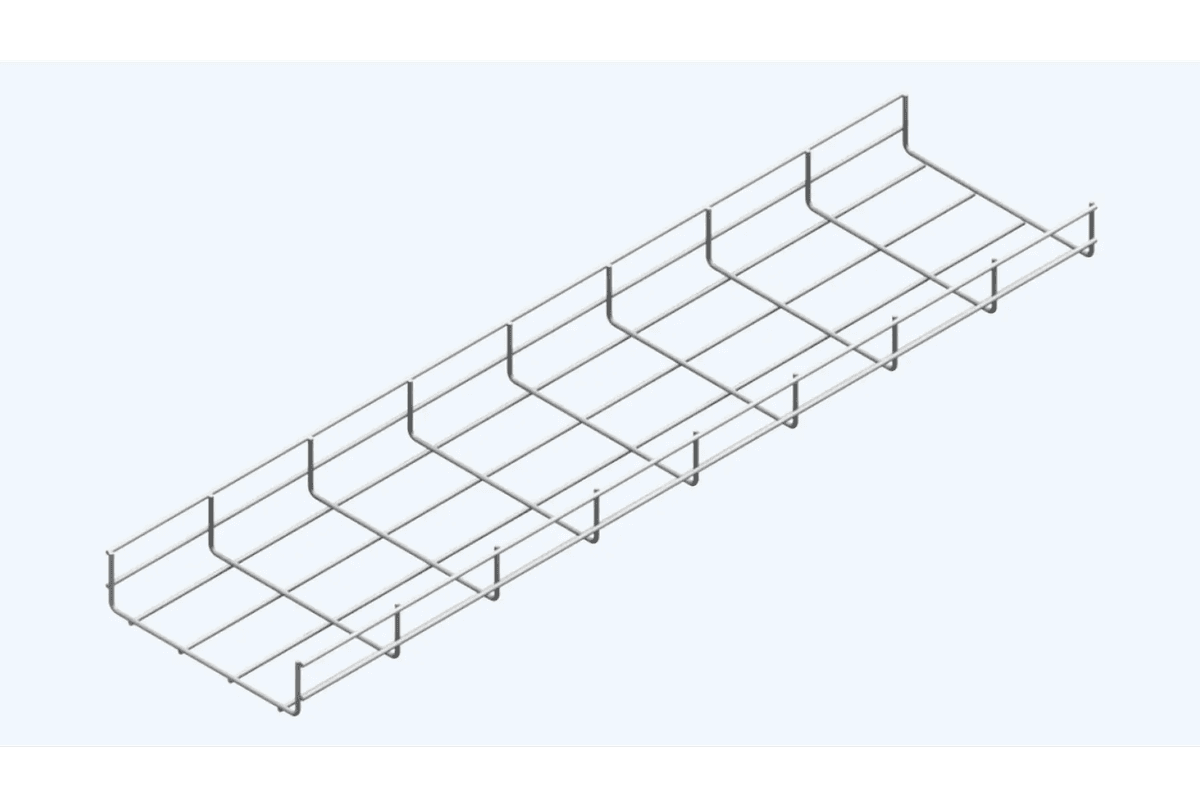
Wire mesh cable trays, also known as basket trays, are constructed from a grid of wires forming a mesh structure. This design is highly flexible and adaptable, making it an excellent choice for dynamic installations.
Benefits
- High Flexibility: Can be easily cut and bent to fit around obstacles and through tight spaces, making them ideal for complex installations.
- Lightweight Construction: The wire mesh design makes these trays lighter and easier to handle during installation.
- Excellent Ventilation: The open mesh structure provides superior airflow and heat dissipation, ensuring the cables remain cool and efficient.
Applications
Wire mesh cable trays are commonly used in data centers, telecom installations, and other environments where flexibility and ventilation are crucial. They are also popular in underfloor and overhead installations, providing an efficient and adaptable solution for cable management.
Size and Dimension
- Width: 2 inches to 24 inches (50mm to 600mm)
- Depth: 2 inches to 6 inches (50mm to 150mm)
- Length: 8 feet to 10 feet (2.4 meters to 3 meters)
- Mesh Size: Typically 2 inches by 4 inches (50mm by 100mm) or 4 inches by 4 inches (100mm by 100mm)
5. Channel Cable Trays
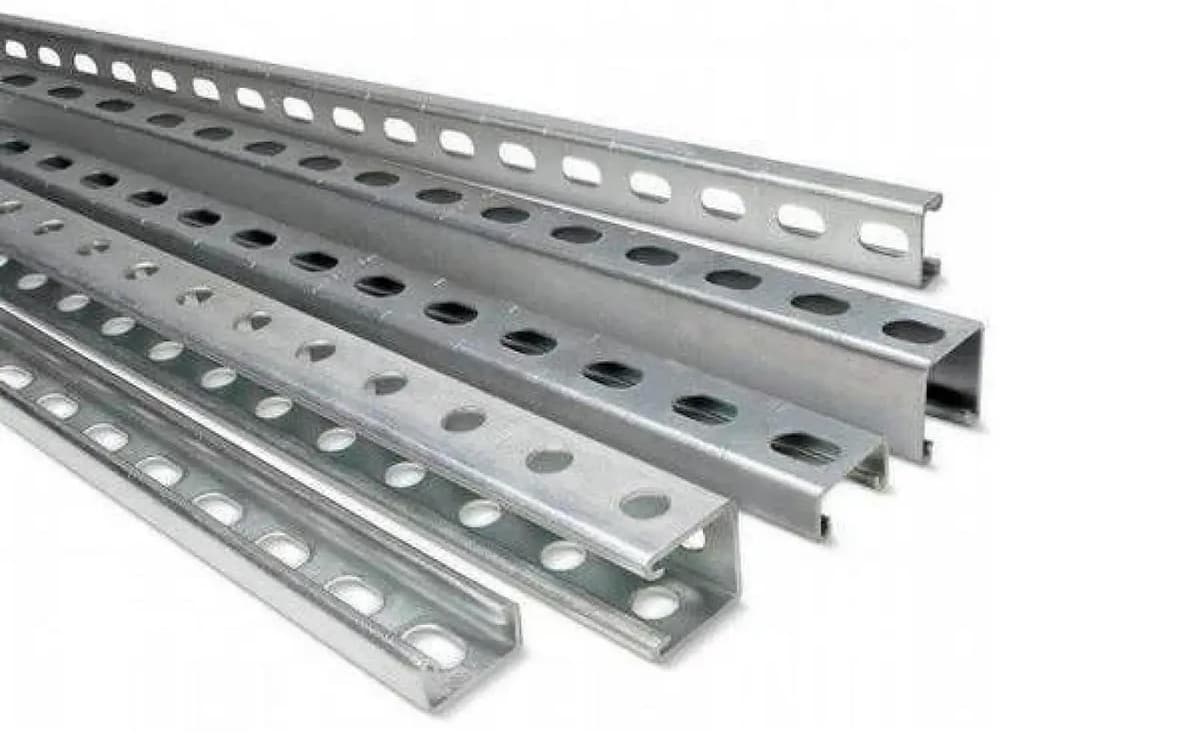
Channel cable trays, also known as trough cable trays, have a U-shaped design with solid or perforated bottoms. These trays are typically smaller in size and are used for supporting smaller cable runs.
Benefits
- Compact Design: Ideal for installations with limited space or for routing smaller cables, providing an efficient use of space.
- Good Cable Protection: Offers protection against dust and debris, ensuring the integrity of the cables over time.
- Versatile Options: Available in various sizes and materials, allowing customization to suit different installation needs
Applications
Channel cable trays are often used in commercial buildings, offices, and smaller industrial settings. They are suitable for routing control, instrumentation, and communication cables, providing a reliable and compact solution.
Size and Dimension
- Width: 3 inches to 6 inches (75mm to 150mm)
- Depth: 1 inch to 3 inches (25mm to 75mm)
- Length: 8 feet to 12 feet (2.4 meters to 3.6 meters)
6. Trough Cable Trays
Trough cable trays are similar to channel trays but are usually larger and more robust. They feature a U-shaped design with either solid or perforated bottoms and sides, providing additional support and protection for the cables.
Benefits
- Robust Strength: Provides excellent support for heavier cable runs, ensuring the stability and security of the installation.
- Enhanced Protection: Offers good protection against environmental factors and mechanical damage, preserving the integrity of the cables.
- High Capacity: Can accommodate a larger volume of cables compared to channel trays, making them suitable for extensive installations.
Applications
Trough cable trays are used in industrial settings, utility plants, and other environments where larger and heavier cable runs need to be supported and protected. They provide a durable and reliable solution for demanding applications.
Size and Dimension
- Width: 4 inches to 24 inches (100mm to 600mm)
- Depth: 3 inches to 6 inches (75mm to 150mm)
- Length: 10 feet to 12 feet (3 meters to 3.6 meters)
- Trough Depth: Typically 1 inch to 2 inches (25mm to 50mm)
7. Fiberglass Cable Trays

Fiberglass cable trays are made from reinforced fiberglass, offering excellent resistance to corrosion, chemicals, and extreme temperatures. These trays are a reliable choice for harsh and demanding environments.
Benefits
- Superior Corrosion Resistance: Ideal for environments with high moisture or chemical exposure, ensuring the longevity of the tray and cables.
- Lightweight Design: Easier to handle and install compared to metal trays, reducing labor costs and installation time.
- Durable Construction: Resistant to UV radiation and extreme temperatures, providing a long-lasting solution for challenging conditions.
Applications
Fiberglass cable trays are commonly used in chemical plants, offshore platforms, wastewater treatment facilities, and other environments where corrosion resistance is crucial. They provide a durable and reliable solution for demanding installations.
Size and Dimension
- Width: 6 inches to 24 inches (150mm to 600mm)
- Depth: 3 inches to 6 inches (75mm to 150mm)
- Length: 8 feet to 12 feet (2.4 meters to 3.6 meters)
- Rail Height: Typically 1.5 inches to 2 inches (38mm to 50mm)
8. Single Rail Cable Trays
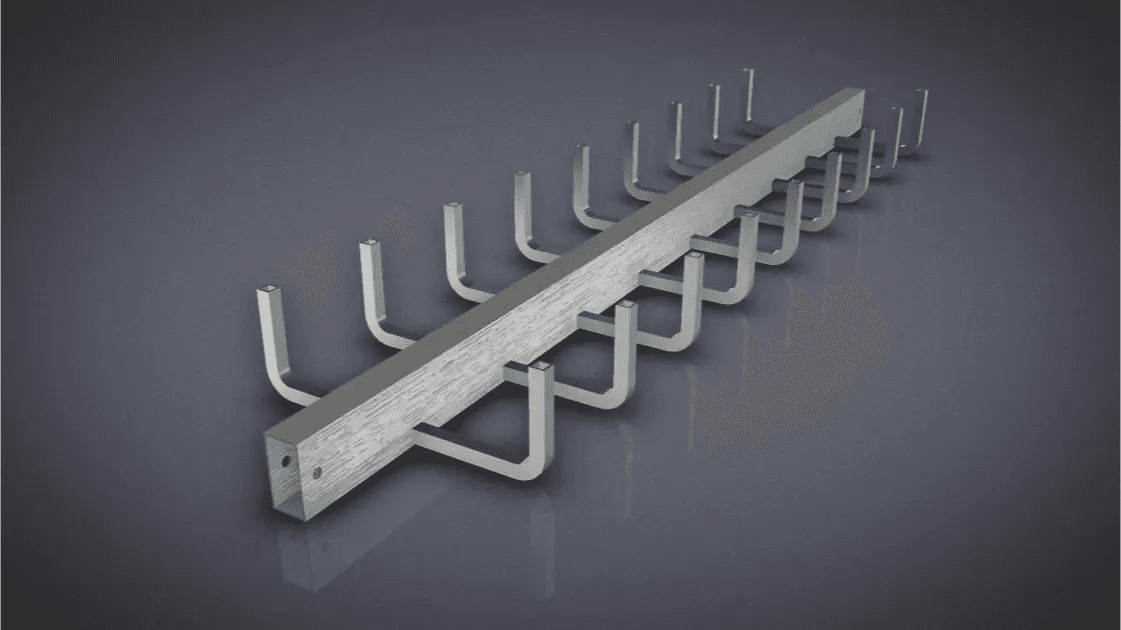
Single-rail cable trays, also known as spine trays, consist of a single central support rail with cantilevered arms to support the cables. This unique design provides a sleek and minimalistic appearance, ideal for modern installations.
Benefits
- Modern Aesthetics: The sleek design offers a contemporary look, making them ideal for visible installations where appearance matters.
- Easy Accessibility: The open design allows for easy access to the cables for installation and maintenance.
- Flexible Installation: Can be installed in various orientations, including horizontal and vertical, providing versatility in different settings.
Applications
Single-rail cable trays are often used in commercial buildings, offices, and other environments where aesthetics and accessibility are important. They are suitable for routing smaller cable runs, providing a stylish and functional solution.
Size and Dimension
- Width: 4 inches to 24 inches (100mm to 600mm)
- Depth: 2 inches to 6 inches (50mm to 150mm)
- Length: 10 feet to 12 feet (3 meters to 3.6 meters)
Type Of Cable Tray Materials
Cable trays come in various materials, each offering distinct advantages and suitable for different environments and applications. Selecting the right material for your cable trays is crucial for ensuring durability, safety, and performance. This section explores the common materials used in cable tray manufacturing and their specific benefits.
1. Steel
Steel is one of the most common materials used for cable trays due to its strength, durability, and versatility. There are different types of steel used, including mild steel, galvanized steel, and stainless steel.
2. Aluminum
Aluminum cable trays are lightweight and corrosion-resistant, making them an excellent choice for many installations. They are often used in environments where weight is a critical factor.
3. Fiberglass Reinforced Plastic (FRP)
Fiberglass-reinforced plastic (FRP) cable trays are made from a composite material consisting of a polymer matrix reinforced with fiberglass. This material offers excellent resistance to corrosion, chemicals, and extreme temperatures.
4. PVC (Polyvinyl Chloride)
PVC cable trays are made from a type of plastic known for its chemical resistance and insulating properties. They are an economical choice for certain applications.
5. Hot-dip galvanized Steel
Hot-dip galvanized steel cable trays are coated with a thick layer of zinc through a hot-dip process. This provides enhanced corrosion resistance compared to pre-galvanized steel.
6. Stainless Steel
Stainless steel cable trays are known for their excellent corrosion resistance, making them suitable for the most demanding environments. Common grades include 304 and 316 stainless steel.
Airbrill Cable Trays: The Best Choice for Cable Management
When it comes to cable trays, choosing the right company can make all the difference. Airbrill is a leading provider of high-quality cable trays, offering a wide range of products designed to meet the needs of various industries. Here’s why you should consider Airbrill for your cable management solutions:
Innovative Design
Airbrill cable trays are designed with the latest technology and engineering practices. They offer enhanced airflow features, ensuring optimal cooling and heat dissipation for high-performance cable installations. The trays are built to provide superior efficiency, reducing installation time and improving overall performance.
Superior Quality
Airbrill is committed to providing products of the highest quality. Their cable trays are made from premium materials, ensuring durability and long-lasting performance. Whether you need trays for industrial plants, commercial buildings, or data centers, Airbrill products are reliable and built to withstand demanding environments.
Lightweight and Durable
One of the standout features of Airbrill cable trays is their lightweight design. Made from high-quality materials, these trays are easy to handle and install, reducing labor costs and installation time. Despite their lightweight nature, Airbrill trays are incredibly durable, providing long-lasting support for your cables.
Enhanced Protection
With Airbrill, you can ensure that your cables are well-protected. Their cable trays offer excellent protection against environmental factors such as dust, dirt, and moisture, preserving the integrity and performance of your cables. This is especially important in environments where cable protection is paramount, such as cleanrooms and laboratories.
Conclusion
Cable trays are essential components in electrical and communication installations, providing support, protection, and organization for cables. Understanding the different types of cable trays and their applications can help you choose the right tray for your specific needs. Whether you're installing cables in an industrial plant, a commercial building, or a data center, there's a cable tray that fits your requirements.
For more information on Airbrill cable trays and to explore their product range, visit Airbrill's official website.

